Yellow line (road marking)
Yellow lines are road markings used in various territories.
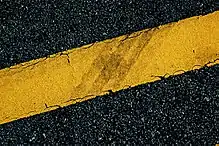
Single yellow lines
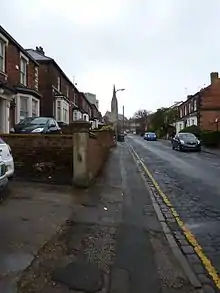
United Kingdom
A single yellow line is a road marking that is present on the side of the carriageway in the United Kingdom. It indicates that parking or waiting at that roadside is prohibited at certain times of day. The exact times vary by area and are indicated by signs at the roadside, or by Controlled Parking Zone entry signs. Stopping to load and to pick up or set down passengers is generally allowed unless additional restrictions apply.[1]
Channel Islands
In the Channel Islands, a yellow line parallel to the road indicates no waiting (in Jersey) or no stopping (in Guernsey) at any time of day.
In Jersey a yellow line perpendicular to the road indicates traffic should wait behind the line until the major road is clear (give way to other traffic) and is often accompanied with a Give way sign or a Yellow yield triangle painted on the road.
In Guernsey a yellow line perpendicular to the road means STOP and Give Way to traffic on the major road. Sometimes a yellow arrow is painted on the road to warn users of a yellow line ahead.
The yellow line for stopping is not used in Alderney or Sark
Commonwealth
Countries formerly part of the British Empire are likely to retain a modified version of the British laws including the basic principles regarding road safety. In Malta for example, a single yellow line, means no waiting (i.e. no parking, but alighting of passengers is permitted). The sign is applicable all day.[2]
Australia
In New South Wales, Australia- single yellow lines indicate a clear way, where parking is strictly prohibited during certain times of the day and/or special events. Single yellow lines are also used in areas with high snow fall to mark the far left side of the road.
Czech Republic, Germany, Belgium, The Netherlands, Poland, Italy
In Czech Republic, Italy, Germany, Belgium, Poland and The Netherlands yellow lines are normally not common in the regular traffic. However, during roadworks, yellow lines overrule the usual white lines to guide the vehicles through the site.
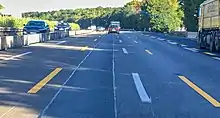
Malaysia
In Malaysia, single yellow lines are used on most roads leading to cities or towns or busy areas to mark parking restriction for certain times.
Philippines
In the Philippines, solid single yellow lines in some cities indicate bus lanes or bicycle lanes, which are restricted lanes for use solely by those vehicles. It is forbidden for vehicles on either side to cross the line. In certain areas, solid lines may give way to segmented single yellow lines which indicate that private vehicles may cross or merge into the bus lane, though buses are still forbidden from merging the other way. Buses still retain right-of-way in such cases.[3][4][5]
Norway
Segmented yellow line used on two lane roads when traffic is coming in opposite directions. Passing is allowed.
Others
In Canada, Japan, Lebanon a single yellow line is used to separate traffic coming from opposite directions, where passing is allowed but with extreme caution. In the United States a yellow line is also used to separate traffic coming from opposite directions, but a solid line indicates that passing is not allowed. A broken yellow line indicates that passing is allowed.
Double yellow lines
Australia
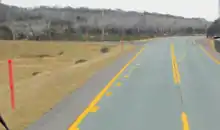
Yellow road lines are used in the centre of the road in areas with large amounts of snow to contrast with the white colour of snow. These lines are white in areas where there is infrequent or no snow.
Canada
In Canada, a double yellow line in the centre of the road means that it is unsafe for traffic travelling in either direction to pass (overtake). This is usually found on rolling hills or through corners where visibility is limited.
In the province of British Columbia, it is against the law to touch or cross solid double yellow line at any time, except to avoid obstructions on the highway,[6] or when a vehicle is entering or exiting the highway, if the vehicle can safely do so without affecting the flow of other vehicles.[7]
Finland
In Finland, a double yellow line in the center of the road means that it is unsafe for traffic travelling in either direction to pass (overtake).
Hong Kong
Hong Kong is one of the regions outside the UK using double yellow lines on the side of carriageways. It means no stopping at any time.
India
A double yellow line, in contrast with a double white line, indicates a no-passing restriction. Double white is just a no-passing suggestion.
Ireland
Double yellow lines on the side of the road have a similar meaning (no parking at any time) as in the United Kingdom.[8] Single yellow line adjacent to a kerb means parking is restricted at certain times. A broken yellow line marks the edge of the carriageway.
Lebanon
In Lebanon, crossing a yellow line means you entered the area where traffic is coming from the opposite direction. A single solid yellow line means that passing is not advised but you may pass, with extreme caution. A single dashed yellow line means passing is allowed. A double solid yellow line means passing is not allowed under any circumstances. A double dashed line means passing is allowed only if there is no cars you can see coming from the opposite direction.
Malaysia
Malaysia was once part of the British Empire, and today still applies double yellow line to mark parking restriction for all times. This line can be found in major towns or cities like Kuala Lumpur.
Malta
A double yellow line means no stopping. This means that unloading of goods and alighting of passengers is not permitted.[2]
Mauritius
Mauritius was once a British colony, and today still applies double yellow lines to mark restricted parking areas at all hours on the sides of carriageways.
Norway
A double yellow line means that passing is forbidden in both directions.
Philippines
In the Philippines, double yellow lines (usually on either side of white segmented lines) indicate it is strictly forbidden for vehicles on either side of the lanes to overtake or counter-flow. These markings are commonly seen on blind curves and in bridges.[3][4][5]
Singapore
Singapore, a former crown colony of the UK, also uses double yellow lines to indicate no parking at the sides.
United Kingdom
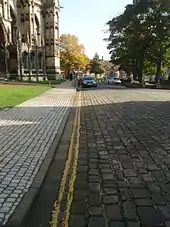
Double yellow lines along the edge of the carriageway indicate that waiting restrictions apply to the road[9] (which includes the carriageway, footway and verge). A driver may stop for passengers to board or alight and to load or unload (unless there are also 'loading restrictions' - see below). The regulation applies to all vehicles. The restriction applies from the centre of the carriageway to the back of the footway.
Loading and unloading is allowed on double yellow lines at any time, unless there are additional markings indicating that there are 'loading restrictions'. A single short yellow stripe at regular intervals across the kerb or edge of the carriageway indicates that loading and unloading is not permitted at the times shown on accompanying black and white sign plates.[10] Two short yellow stripes at regular intervals across the kerb or edge of the carriageway indicate that loading and unloading is not permitted at any time (and the sign plates may be omitted). Loading/unloading time may be restricted, depending upon the local authority making the restriction. One must not cause an obstruction to traffic or pedestrians.[11]
History
Double yellow lines mean no waiting at any time, unless there are signs that specifically indicate seasonal restrictions.[10] They were first introduced in the UK by section 51[12] of the Road Traffic Act 1960[13] (repealed in 1972 and replaced by later legislation).
Countries that were once part of the British Empire are likely to retain a modified version of the British laws including the basic principles regarding road safety.
United States

A yellow line (solid or dashed) indicates that crossing the line will place a driver in a lane where opposing traffic is coming at the driver. A double yellow line is a painted marking separating two lanes of a road. It consists of two parallel, solid yellow lines, and its presence usually indicates a no-passing restriction or no passing zone, where crossing the line is prohibited. Obvious exceptions to this no-passing restriction include emergency maneuvers or temporary traffic flow changes due to road work. Often the double yellow line has sections where one of the lines becomes dashed (in which case it is no longer a "double yellow"), indicating to the drivers traveling on the side closest to the dashed line that they may pass when it is safe. Double-yellow lines may be used to separate lanes of traffic traveling in opposite directions where passing would be dangerous, or to restrict access to lanes traveling in the same direction, such as HOV and express lanes on a highway.
Two municipalities in the state of Rhode Island, Bristol and Warwick, replace the double yellow line with red, white, and blue striping along certain routes.
In some states, it is not against the law to overtake vehicles in the presence of solid yellow lines if it is safe to do so. For example, Vermont State Law also allows passing across the double yellow line when no traffic is on the opposing side,[14] however, one must pass quickly and return to the proper side.[14] Pennsylvania does permit passing on double yellow lines when not also posted with "Do Not Pass" signage.[15][16] However, this is unusual as most states have a ban on crossing a double yellow line except when turning and only when it is safe to do so, when passing pedestrians or bicycles, or if an obstruction in the road makes it necessary. Overtaking another vehicle across a solid yellow line is usually considered a serious traffic violation in most states.[14]
Some parts of the US use a doubled set of double yellow lines (sometimes called "double-double yellow lines") to demarcate a painted median strip, which vehicles are not permitted to cross. This differs from a single set of double yellow lines, which may be crossed in certain circumstances.[17]
References
- "The Highway Code, road safety and vehicle rules - GOV.UK". www.gov.uk.
- "Traffic signs & carriageway markings regulations". Government of Malta. Retrieved 16 April 2013.
- Roces, Inigo S. "Common road markings and what they mean". AutoIndustriya.com. Retrieved 5 September 2018.
- Sarne, Vernon B. "If you see those double yellow lines on the road, here's what you should do". Top Gear Philippines. Retrieved 5 September 2018.
- "9 Basic Road Markings in the Philippines and What They Mean". Toyota Motors Philippines. Retrieved 5 September 2018.
- Motor Vehicle Act Section 155 BC Laws
- Motor Vehicle Act Section 156 BC Laws
- "Traffic signs & road markings for parking". Road Safety Authority. Retrieved 16 April 2013.
- "Waiting and parking (238 to 252)". Retrieved 2013-04-30.
- "Road markings" (PDF). direct.gov. Retrieved 2010-04-01.
- londoncouncils website
- "Road Traffic Act 1960 - 51 Traffic signs". Legislation.gov.uk.
- "Parking Meter Zones (Double Yellow Lines)". Hansard.
Mr. Marples: Double yellow lines on the carriageway in a parking meter zone indicate a ban on waiting at all times, except for the picking up or setting down of passengers; they also indicate a ban on loading or unloading between 8.30 a.m. and midnight. I have authorised the use of these carriageway markings under the powers given to me in Section 51 of the Road Traffic Act, 1960.
- "Vermont DMV - Home - Department of Motor Vehicles". dmv.vermont.gov.
- "Title 75". The official website for the Pennsylvania General Assembly.
- "Mcall.com: The Road Warrior w/Dan Hartzell : Reversing Monday's Reversal on Double-Yellow Passing". blogs.mcall.com.
- "Crossing double yellow lines", Spokesman-Review, April 28, 2014.